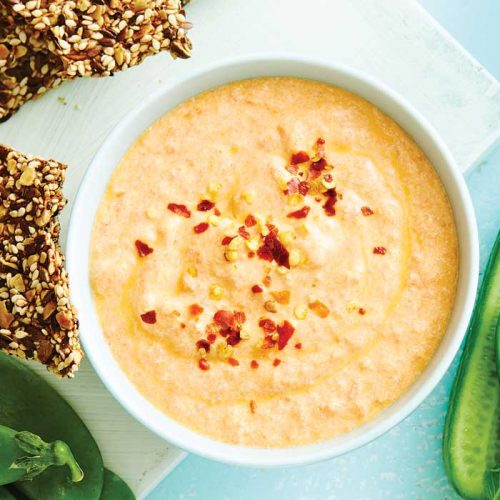
Carrying too much weight around your belly can be a risk factor for multiple chronic conditions from heart disease to type 2 diabetes. Karen Fittall talks to the experts to discover five common causes of weight gain around the stomach and how to manage it.
Keeping your weight within its healthy range is one thing. But just as important – if not more so – is paying attention to where on your body the extra weight starts to gather, since locations aren’t all created equal as far as overall good health is concerned.
The short story is that carrying too much weight around your stomach delivers the biggest health risk, increasing your likelihood of experiencing everything from heart disease and diabetes to a faster decline in what is known as ‘fluid intelligence,’ the type of intelligence that influences your short-term memory and problem-solving capability.
So how much tummy fat is too much? One way to gauge whether you’re carrying excess belly fat is by calculating your waist-to-height ratio. You can do this by dividing your waist measurement in centimetres by your height in centimetres. A ratio no greater than 0.5, so that your waist circumference is less than half your height, is recommended for overall good health.
Done the maths and decided you would like to shrink your stomach a bit or a lot? Read on to find out what our panel of experts has to say about why your waist size may have increased over the years, and what you can do about it.
1 You’ve been through menopause
Australian research has found that menopause doesn’t cause midlife weight gain for women, but it does change the distribution of body weight, making it more likely to accumulate around the stomach. The exact mechanism for this isn’t known, but it’s related to the decline in oestrogen that occurs at menopause.
What the expert says
Carly Ryan s an accredited exercise physiologist and Standards Manager at Exercise & Sports Science Australia.
To fight the effect… Get moving
Exercise physiologist Carly Ryan, from Exercise & Sports Science Australia, says doing regular exercise is key. Research backs this up, with one study finding postmenopausal women who undertook a 12-week circuit training program reduced their waist circumference, even though their body weight remained the same.
“While you can’t choose where to lose weight when exercising, which means sit-ups strengthen your abdominal muscles but don’t guarantee you’ll lose fat around your stomach, being physically active after menopause is vital for so many reasons, including good heart and bone health,” stresses Carly. “It’s never too late to start and every bit of movement adds up – even 10 or 15 minutes here and there – so you accumulate at least 150 minutes of moderate-intensity activity (see box right) a week. Doing different types of exercise is also vital, including cardio and flexibility, as well as resistance exercises to help maintain bone strength and muscle mass post menopause.”
Are you working out at the right level?
Moderate-intensity exercise includes activities like brisk walking, uphill walking, swimming, cycling and dancing. The talk test (see below) will help you find out what level you’re exercising at.
- Low intensity You can talk and sing while you exercise, without feeling puffed or getting out of breath.
- Moderate intensity You can talk comfortably while you exercise, but cannot sing.
- High intensity You can’t speak much at all while exercising, without gasping for breath.
2 You’re eating too much sugar
A recent US study made the link between consuming too much added sugar and weight gain, specifically abdominal weight gain. And while the World Health Organization recommends limiting your intake of ‘free sugars’ – those that are added to foods and drinks – to six teaspoons a day, most Australians consume more than double this amount of added sugar a day.
What the expert says
Milly Smith is an accredited practising dietitian specialising in weight and diabetes management, as well as eating disorders.
To fight the effect… Cut back on sugar
Accredited practising dietitian Milly Smith recommends avoiding sugar-sweetened drinks and fruit juice to cut back on added sugar. She also advises you remember that sugar is sugar, whether it’s white, raw, brown or even honey.
“When it comes to the added or free sugars in people’s diets, sugary drinks are the main culprits,” says Milly. On its own, a can of regular soft drink contains nine teaspoons of sugar and a glass of fruit juice contains six teaspoons. “But some foods with a healthy reputation, such as granola, can also contain large amounts of added sugar. You don’t need to quit sugar, but choose products with less than 10g of it per 100g, or 20g per 100g if fruit is one of the main ingredients,” she advises.
3 You’re a fad dieter
Lab-based studies reveal that while crash-style diets, which severely restrict kilojoules, lower body weight in the short term, not only does the weight return when the diet ends, it’s also more likely to accumulate around the stomach than pre-diet.
Earlier this year, Australian scientists discovered intermittent fasting diets calling for every-other-day fasts may also encourage stomach fat to adapt and protect itself over time, making it resistant to weight loss.
What the expert says
Nick Fuller is an obesity expert who runs the clinical research program at the Boden Institute at the University of Sydney’s Charles Perkins Centre.
To fight the effect… Ditch the diet
Nick Fuller, a leading obesity researcher at the University of Sydney’s Charles Perkins Centre, says we need to quit dieting.
“As humans, we have an evolutionary propensity to get back to the weight we were before the diet, which is our ‘set point’,” he explains.
Research agrees, finding that a common side effect of diet-induced weight loss is a slower metabolism and lower levels of appetite-suppressing hormones. “Combined, it helps the body regain the weight that’s been lost, and as the weight goes back on, it’s usually more fat than muscle. Your body composition is then worse off, which contributes to a slower metabolism, so you’ll probably gain more weight than you originally lost, too. And then this higher weight becomes your new set point,” he explains.
Instead, Nick’s research supports something called interval weight loss using simple, sustainable lifestyle changes rather than severely restricting kilojoules or food groups. “We’ve discovered that gradual weight loss of two kilos one month, followed by a month-long weight-loss break, resets or lowers the body’s set point. This allows you to lose 12kg – and keep it off – in one year, when people usually lose that amount in just a few weeks on a diet and then put it all, and often more, back on,” he concludes.
4 You’re often stressed
Not only do three out of four people say stress is affecting their health, research shows there’s a strong link between stress and the accumulation of abdominal fat. It’s thanks to the way cortisol, a hormone that’s released mainly during times of stress, influences where fat gets stored on the body.
What the expert says
Emmanuella Murray is a clinical psychologist with 10 years of experience, and a leading spokesperson on a range of mental health topics.
To fight the effect… Breathe
Clinical psychologist Emmanuella Murray says that even though you can’t eliminate all stress from your life and that sources of stress vary among people, you can do things to reduce its impact.
“As well as committing to proven ‘recharging’ strategies, such as exercising regularly, eating well and getting good sleep, something as simple as how you appraise a situation can either relax or stress you out,” Emmanuella explains. “Simply recognising that your thinking is unrealistic may help you feel better. Using diaphragmatic breathing can also release tension in your body and still your mind, which can help you ease off any catastrophic thoughts you’re having and give you space to look for a solution instead.”
In addition, research shows that practising diaphragmatic breathing, which means breathing so your stomach rather than your chest moves, lowers both stress and cortisol levels.
How to do diaphragmatic breathing
- Sit in a comfortable position or lie flat on the floor or bed. Relax your shoulders.
- Place one hand on your chest and the other on your stomach.
- Take two seconds to breathe in through your nose. You should feel the air moving through your nose into your abdomen, so your stomach expands. As you do this, make sure your stomach is moving outwards as you breathe in, while your chest remains fairly still.
- Purse your lips (like you’re going to drink through a straw), then gently press on your belly while you exhale slowly for two seconds.
- Repeat several times for best results.
5 Your gut isn’t playing for your team
A 2019 study of twins in the UK discovered that the make-up of gut microbiota is a better predictor of the presence and accumulation of belly fat than diet. In fact, while specific gut bugs are linked to an increase in belly fat and others to reduced belly fat, the research also discovered that dietary changes will be ineffective for weight loss unless ‘good bacteria’ are living in your gut.
What the expert says
Melissa Lane is a PhD candidate within Deakin University’s Food & Mood Centre, with an interest in the link between the gut, diet and health outcomes.
To fight the effect… Boost gut health
Melissa Lane, a research fellow at Deakin University in Victoria, where dietary interventions in obesity have been linked to changes in gut bacteria, says it’s our diet that significantly impacts the composition and diversity of the bugs that live in our gut.
“The idea that we can modify our gut bacteria through changes to our diets is an empowering one, and research shows we can change the composition of our gut bacteria, for better or worse, within a matter of days,” she explains.
“In general, eating a diet rich in plant-based whole foods – vegetables, fruit, whole grains, legumes, nuts and seeds – promotes a greater variety of gut bugs.”
In part, that’s because specific foods from all of those categories are rich in prebiotic fibres that feed your gut’s good bacteria, including onion, corn and asparagus; nectarines, watermelon and grapefruit; oats, barley and couscous; chickpeas, lentils and red kidney beans; and cashews and pistachio nuts.
But the beneficial changes to gut bacteria associated with eating a fibre-rich diet only last for as long as you continue to consume a variety of high-fibre foods every day.
Other ways to help improve your waistline
Improve posture
To reduce the appearance of a prominent belly, try standing and sitting ‘tall’ to prevent yourself from slouching. Poor posture can make a belly look much bigger than it actually is.
Beat bloat
Hormonal changes can cause bloating, but some foods may exacerbate it, as can too much salt. We’re all different, so if you’re prone to bloating, keep an eye out for food triggers.
Reduce carbs
Refined carbohydrates are energy-dense and low in nutrients. Eat more nutrient-rich, low-kilojoule/calorie foods to help shift excess belly fat.
Article sources and references
- Ashwell M et al. 2014. Waist-to-height ratio is more predictive of years of life lost than body mass index. PLoS One. 8:9(9) e103483.https://journals.plos.org/plosone/article?id=10.1371/journal.pone.0103483
- Australian National University. 2019. Menopause ‘not the cause of midlife weight gain’ in women. Accessed March 2021.https://www.anu.edu.au/news/all-news/menopause-%E2%80%98not-the-cause-of-midlife-weight-gain%E2%80%99-in-women
- Cleveland Clinic. 2019. Diaphragmatic breathing. Accessed March 2021https://my.clevelandclinic.org/health/articles/9445-diaphragmatic-breathing
- urekAlert. 2019. Changes in the immune system explain why belly fat is bad for thinking. https://www.eurekalert.org/pub_releases/2019-12/isu-cit121719.php
- Health Direct. 2020. The role of cortisol in the body. Accessed March 2021https://www.healthdirect.gov.au/the-role-of-cortisol-in-the-body
- University of Minnesota. 2020. School of Public Health. Excess sugar linked to dangerous heart and abdominal fat. https://www.sph.umn.edu/news/excess-sugar-linked-to-dangerous-heart-and-abdominal-fat/
- Xiao Ma et al. 2017. The effect of diaphragmatic breathing on attention, negative affect and stress in healthy adults. Front Psychol. 8: 874.https://www.frontiersin.org/articles/10.3389/fpsyg.2017.00874/full
www.healthyfood.com
















